The Checker Maven
The World's Most Widely Read Checkers and Draughts Publication
Bob Newell, Editor-in-Chief
Published each Saturday morning in Honolulu, Hawai`i
Contests in Progress:
We're Dunne

In our long-running Checker School series, we've featured Ben Boland's Famous Positions in the Game of Checkers. We're almost to the end of that book and this will be the last study from that source. Later, we'll move on to other positions and books of a suitably didactic nature.
It's fitting, then, to be "Dunne" with a position attributed to old-time checker great Frank Dunne.
BLACK
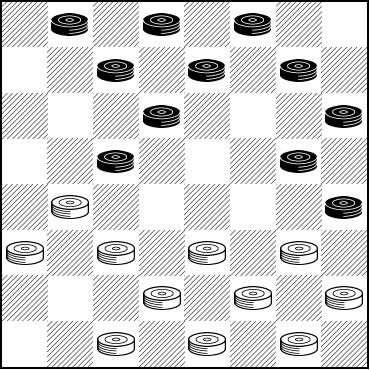
WHITE
White to Play and Win
W:W32,31,30,28,27,26,24,23,22,21,17:B20,16,14,12,10,8,7,6,3,2,1.
This isn't especially easy, and in Mr. Boland's notes, he points that out but is most unusually judgmental of a player who didn't find the win. In defense of the fellow that lost, this is an 11x11 position and it's easy to stray from the path.
Fortunately, The Checker Maven will never judge; we only encourage, and in this case, we urge you to find the solution. Don't stop until you're Dunne, and then click on Read More for the usual sample games and analysis.![]()
Logical Checkers, Volume One

Photo courtesy Katherine Pask
Richard Pask has retired! Actually the photo above dates back to mid-2017, when Richard did indeed retire from his position as an educator.
But retired, for Richard, may mean something very different from what it means to others; this gentleman has been very busy indeed. Last week we published his revised edition of Complete Checkers, and this week we're proud to put forth the first book in his new series, which is called Logical Checkers.
The series, expected to consist of five volumes, will present a layered approach to checker tuition, from novice through master. Book 1 is the "Novice" guide but it contains much of interest even to a more experienced player. Rules and basic principles, tactics and strategy, common endgames, and an initial opening repertoire (for Go As You Please players) are all presented in 127 full-size pages illustrated with 128 diagrams.
Down the road, after the series is completed, we plan to once again offer a combined edition in both electronic and print formats.
We predict that Logical Checkers will do no less than revolutionize checker tuition.
Richard, once again, is very generously giving us his work free of charge. It can be downloaded here or from the Richard Pask page as linked in the right-hand column.
Here's one of the tactical examples given in the book.
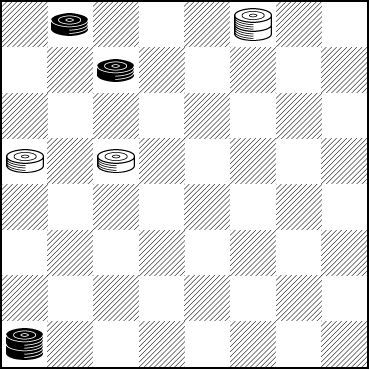
WHITE
White to Play and Win
W:W14,13,K3:BK29,6,1.
It's not that hard; this is, after all, a book aimed at relatively new players. But it's nonetheless pleasing. See how quickly you can find the solution and then click on Read More to see how you did. And be sure to grab your copy of the new book. Thank you, Mr. Pask!![]()
Complete Checkers, 2nd Edition
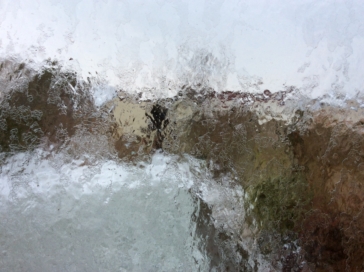
Photo by Katherine Pask
The weather in the Dorset area, on England's south coast, hasn't been so great this winter. The photo above is of a frozen-over window in Richard Pask's home. Brrr!
But if the cold weather has kept Richard indoors, we are the beneficiaries, for today we're pleased to announce the immediate availability of the second edition of Richard Pask's landmark work, Complete Checkers. This edition incorporates about 100 changes, updates, and corrections. The Checker Maven thanks Mr. Pask for the continuing privilege of publishing and presenting his work to you, the checker players of the world.
Of course, the revised book can be downloaded in PDF format, completely free, either here or from our Richard Pask page, as linked in the right-hand column. The printed edition has also been updated and can be obtained from Amazon's US, UK, and European outlets (although going to the expense of replacing your first edition printed copy is by no means necessary).
Here's an example of a new idea in the new edition.
| 1. | 11-15 | 24-20 |
| 2. | 8-11 |
This is Ballot 102.
| 2. | ... | 28-24 |
| 3. | 9-13 | 22-18 |
| 4. | 15x22 | 25x18 |
| 5. | 3-8 | 26-22 |
| 6. | 5-9 | 30-26 |
| 7. | 1-5 | 32-28 |
| 8. | 9-14 | 18x9 |
| 9. | 5x14 | 22-17 |
| 10. | 13x22 | 26x17 |
| 11. | 11-16 | 20x11 |
| 12. | 8x15 |
Several moves draw here. In the 1st edition, with play attributed to Willie Ryan, Richard showed a draw after 29-25, but in the second edition, 24-19! is presented (also attributed to Ryan). The computer tells us that 24-20 and even 17-13 are also probably draws, although the draws are definitely more difficult than in the line of play after the brilliant 24-19. (For subsequent play after 24-19, refer to the book, game #1748 on page 482.)
But what if White tries a hasty and badly mistaken 31-26? Then we have this:
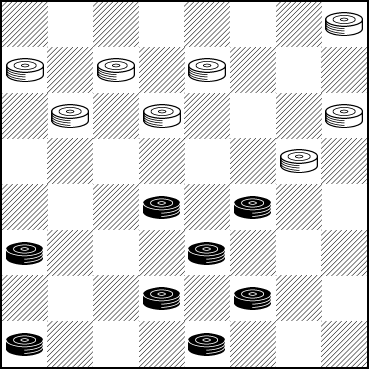
BLACK
Black to Play and Win
B:W29,28,27,26,24,23,21,17:B15,14,12,10,7,6,4,2.
It doesn't look so good for White, does it? Black indeed has a win. But can you show it over the board? It isn't especially difficult if you know the technique, but it's one of those highly practical things that you simply must know if you're to succeed at the upper levels of the game.
See how you do (are you stuck indoors too?) and then click on Read More to view the solution.![]() >
>
A Trap With A Tale, Part 4: A Narrow Draw

The photo above shows a very narrow drawbridge somewhere in Holland. Now, in checkers there are bridges and draws, and some of those draws are narrow indeed. Today, we'll look, not at a bridge, but at a narrow draw, which we'll define loosely as one that is difficult to find over the board and requires precise play, hewing to a "narrow" path.
We've been exploring the final part of Willie Ryan's Tricks Traps & Shots of the Checkerboard with a series of variations on some rather tricky play. Today, we ask you to join Willie in helping the White pieces find a narrow draw.
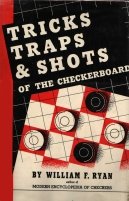
Here's the run-up one more time, with just a couple of notes as reminders.
| 1. | 11-16 | 24-19 |
| 2. | 8-11 | 22-18 |
| 3. | 16-20 | 25-22 |
| 4. | 9-13 | 29-25 |
| 5. | 11-15 | 18-11 |
| 6. | 7-16 | 22-18---A |
| 7. | 20-24 | 27x11 |
| 8. | 10-15 | 19x10 |
| 9. | 6x29 | 28-24 |
| 10. | 29-25 | 32-27 |
| 11. | 1-6 | 24-19---B |
| 12. | 6-9---C |
A---Loses. 28-24 and several other moves would draw.
B---Willie claimed that this draws, but the game was lost earlier.
C---Black's winning move was 25-29; now White can draw.
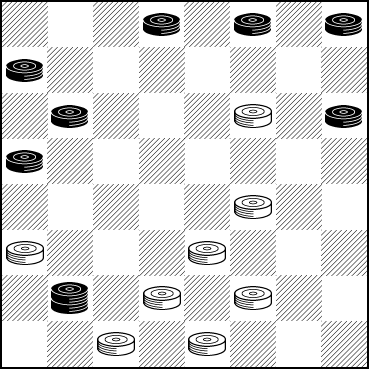
WHITE
White to Play and Draw
W:W31,30,27,26,23,21,19,11:BK25,13,12,9,5,4,3,2.
This one is tough, no doubt about it, and the path is indeed narrow and long. Still, it's a really terrific study, filled with checker wisdom. Do give it more than a narrow try before clicking on Read More to see the solution and notes.![]()
The Evil Twin
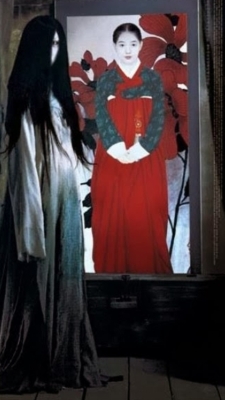
Last month we presented a "twin" problem by Brian Hinkle. Today's Checker School entry is a bit reminiscent of the "twin" idea. Originally found in Ben Boland's classic Famous Positions in the Game of Checkers, Mr. Boland showed a position in which, supposedly, if Black plays then White wins, while if White plays, then Black wins.
But much to our surprise, we found that, in the original edition of the book, the second member of the twin was in error!
The first problem, which Mr. Boland says isn't that difficult for top players, requires quite a lot of nuanced play.
WHITE
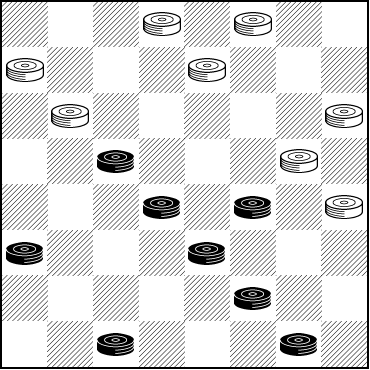
BLACK
Black to Play, White to Win
B:W31,30,28,26,24,21,17,13:B19,15,14,12,10,6,3,1.
The second problem, which existed for many years without the correct solution being found, may prove difficult, but honestly, we thought it was relatively straightforward--- if and only if you find the correct first move, something that eluded the experts. (We understand that the problem terms and solution were corrected in a later edition of Mr. Boland's book.)
BLACK
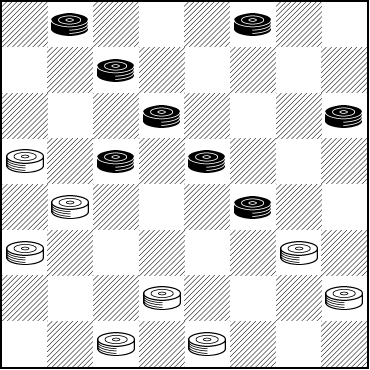
WHITE
White to Play and Draw
(originally White to Play, Black to Win)
W:W31,30,28,26,24,21,17,13:B19,15,14,12,10,6,3,1.
It's not a "twin" problem; it's more like the "evil twin." Can you solve both parts? If you can, consider yourself a top player, but in any event, clicking on Read More will show you the solutions, several sample games, and detailed notes and analysis.![]()
Lucky 13

For reasons that we won't go into here, the number 13 is considered unlucky by some. Yet, for us, it's always been just the opposite, and in fact, this week The Checker Maven completes 13 years of uninterrupted, no-fail on-time weekly publication. It's a record we're proud of, and we hope to be able to carry on until our projected wrap-up at the 15 year mark.
To celebrate our 13th anniversary, we turn to Richard Fortman's Basic Checkers and explore one aspect of Ballot No. 13: 9-13 23-19 5-9. It's a reasonably balanced ballot, with maybe a little advantage to White.
| 1. | 9-13 | 23-19 |
| 2. | 5-9 | 27-23 |
(22-18 also a good choice instead of 27-23.)
Black is lucky; there are actually four moves to draw at this point. Mr. Fortman gives 11-15, which is arguably the best, but it isn't the only one. 9-14 or 11-16 or 10-14 instead of 11-15 also draw.
Fortman calls the first two probable White wins but they are all draws, though perhaps rather narrow ones.
For the purpose of today's study, let's consider 11-16 with the likely reply 22-18.
| 3. | 11-16 | 22-18 |
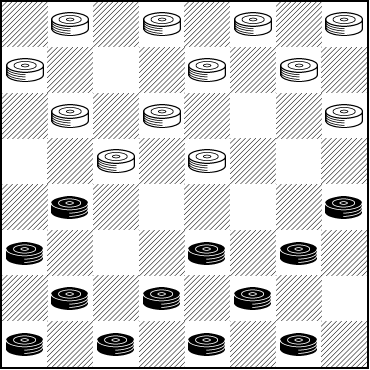
BLACK
Black to Play and Draw
B:W32,31,30,29,28,26,25,24,23,21,19,18:B16,13,12,10,9,8,7,6,4,3,2,1.
In the book, Mr. Fortman gives 16-20 as Black's next move. This gives White a substantial edge, and though we wouldn't yet call it a White win, Black is going to face a hard time.
What should Black play instead to ensure a draw? Can you sketch out a possible line of play?
We're asking you to match wits with one of the great checker analysts of all time. But it's a great exercise, and, luckily, clicking on Read More will show you the solution.![]()
Pretty as a Picture (Frame)

A pretty picture deserves a pretty frame. In our experience very often the frame, if it is one of quality, is more costly than the picture itself.
There's a picture frame in checkers, too, or more precisely, a picture frame position, and it's the subject of this month's Checker School column. Here's the pretty as a picture position.
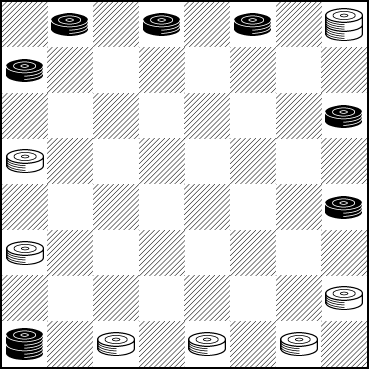
WHITE
White to Play and Draw
W:W32,31,30,28,21,13,K4:BK29,20,12,5,3,2,1.
As you'll see in the solution notes, it was once thought that this was a win for whoever played first, but actually, it's a draw either way. It's somewhat complex, and in fact we've corrected a couple of errors in Ben Boland's published solution. But, you get the picture.
In fact, we invite you to stay in the picture and try to solve the problem. And picture this: clicking on Read More will show you the solution, sample games, and comments and corrections.![]()
A Couple of Surprises

Surprise! Some surprises are good, some others are not, but in today's Checker School entry, we think you'll find a nice surprise ... two of them, in fact.
BLACK
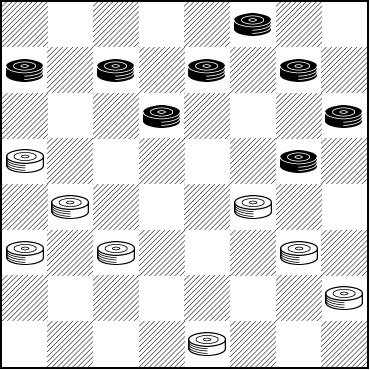
WHITE
White to Play and Draw
W:W31,28,24,22,21,19,17,13:B16,12,10,8,7,6,5,3.
We found this study very interesting in that the game is played quite flawlessly on both sides, yet White ends up with a draw that could prove difficult to find over the board, requiring two "surprises."
Will you find the solution or just be surprised? Either way, it's no surprise that clicking on Read More will show you the solution, a sample game, and some explanatory notes.![]()
A Trap With a Tale, Part 3: An Easy Tale

"It's easy when you know how" could also be the theme of today's little study, but we think the deeper truth is found in another adage: When someone makes something look easy it's because they've worked hard.
We're continuing with one of the final chapters of Willie Ryan's Tricks Traps and Shots of the Checkerboard with a problem that's easier than usual, "An Easy Tale" if you wish; at least, it's easy if you've worked hard enough at your visualization skills.

Let's begin with a run-up that we've already seen a couple of times, so no further commentary is required.
| 1. | 11-16 | 24-19 |
| 2. | 8-11 | 22-18 |
| 3. | 16-20 | 25-22 |
| 4. | 9-13 | 29-25 |
| 5. | 11-15 | 18-11 |
| 6. | 7-16 | 22-18 |
| 7. | 20-24 | 27x11 |
| 8. | 10-15 | 19x10 |
| 9. | 6x29 | 28-24 |
| 10. | 29-25 | 32-27 |
| 11. | 1-6 | 24-19 |
Recall that Willie said this move draws, but last time we showed that if Black plays the odd-looking 25-29, Black would have actually won. However Willie gave this as the next move:
| 12. | 6-9 |
which only draws (even if the White draw is very narrow). We'll follow that path further next time, rather than stopping here with "White to Play and Draw." Instead, we'd like to look at what happens if White makes this seemingly feasible move:
| 12. | ... | 23-18 |
resulting in the position below.
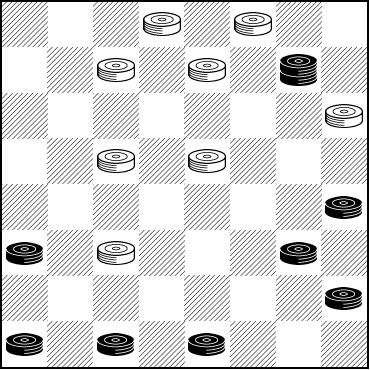
BLACK
Black to Play, What Result?
B:W31,30,27,26,21,19,18,11:BK25,13,12,9,5,4,3,2.
We're pretty sure you know what the outcome will be, but can you show it? It truly isn't all that difficult, but it's definitely a lot of fun. Tell the tale and then click on Read More to verify your solution.![]()
Double Arrow

Onward and upward! Do these two arrows point the way to success? And will that success be on the checkerboard?
Today's Checker School entry, a position attributed to William Strickland, certainly looks like two arrows pointing upward -- from the Black side. (From the White side, the arrows point in a quite different direction.) Let's take a look.
WHITE
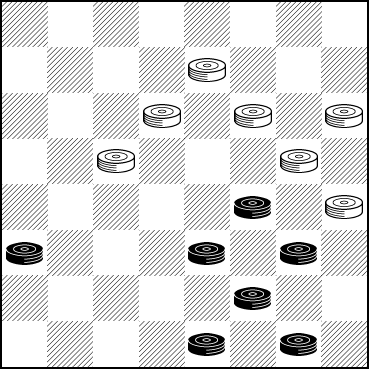
BLACK
Black to Play and Draw
B:W26,23,22,21,19,17,13:B14,12,10,9,6,2,1.
In the interest of fairness, we presume, the terms are Black to play and draw, and that would certainly be a success in such an awkward position. As for White, it's his game to win ... if he can.
Will your arrow hit the mark? Solve the problem and then shoot your mouse onto Read More to see the solution, explanatory notes, and seven--- yes, seven--- sample games.![]()
The Checker Maven is produced at editorial offices in Honolulu, Hawai`i, as a completely non-commercial public service from which no profit is obtained or sought. Original material is Copyright © 2004-2024 Avi Gobbler Publishing. Other material is the property of the respective owners. Information presented on this site is offered as-is, at no cost, and bears no express or implied warranty as to accuracy or usability. You agree that you use such information entirely at your own risk. No liabilities of any kind under any legal theory whatsoever are accepted. The Checker Maven is dedicated to the memory of Mr. Bob Newell, Sr.

